Part 1: Chronic fatigue is premature aging
When your body is chronically fatigued, one of two things happens. You may use up your minerals too quickly until you develop deficiencies. This is what happens in fast oxidation.1
The second possibility is that you will be unable to utilize your minerals. They will deposit in your blood vessels and other tissues and choke your system. This is what happens in slow oxidation.2
Either route leads to premature aging.
By balancing the body chemistry, you can actually eliminate fatigue and reverse aging.
By balancing the body chemistry, you can eliminate excess fatigue. Then, the minerals will be used at a proper rate and in a proper way. This is what we mean by balanced oxidation, which is neither too fast nor too slow.
Once we approach a state of balanced oxidation, premature aging will be prevented. Or, if it has already occurred, it will be reversed.
Let us look at all this in a little more detail. You will find it fascinating.
It is the sodium and potassium controlled by your adrenal glands (and thyroid too) that keep your body pliable and flexible. Sodium and potassium are the great solvents in the body. They keep everything in solution that should be in solution.
When you are chronically fatigued, your thyroid and adrenal glands become exhausted. When this occurs, your sodium and potassium can go either too low or too high. Too low is slow oxidation. Too high is fast oxidation. Let us take slow oxidation first.
If your sodium and potassium levels go too low, it means there is not enough solvent left in your body. So your minerals begin to drop out of solution. They precipitate. They begin to pile up in your tissues, arteries, joints, your heart, your skin, etc. You become less flexible. In other words, you age prematurely.
The process is the same whether you are 20 years old and exhausted, or whether you are 65 years old and exhausted. Exhaustion is premature aging. There is no way around it.
How slow oxidation causes premature aging
You can compare slow oxidation to a woodstove that is not getting enough air. The fire is not hot enough. Combustion is not complete. Residues form, i.e., clinkers, and these clog up the stove. Eventually, they clog it so much that the fire goes out.
This is how slow oxidizers age. Their bodies suffocate. For example, when doctors perform autopsies on the hearts of slow oxidizers, they find clinkers in the form of iron deposits, manganese deposits, calcium deposits, etc. These deposits lead to rigidity which means that – to one degree or another – the slow oxidizer is actually turning into stone.
How fast oxidation causes premature aging
Before we discuss fast oxidizers, we must make one thought clear to you. Fast oxidizers are just as tired as slow oxidizers. The only difference between fast and slow oxidizers is how they react to fatigue.
The slow oxidizer slows down to conserve energy. The fast oxidizer speeds up to compensate for his underlying lack of energy. He burns out the little reserves he has, so that he does not have to slow down. The fast oxidizer appears to have more energy than the slow oxidizer. But, as we said before, he is just as tired.
You can recognize fast oxidizers because they seem to be running on nervous energy, not calm energy. They are hyped up. They have to be, to keep going. But there are consequences.
When the thyroid and adrenals of the fast oxidizer become overactive, the sodium and potassium levels go too high. This causes too many minerals to go into solution. To keep going, the body starts cannibalizing tissues for minerals in the same way you would strip down a car for parts.
A fast oxidizer can be compared to a furnace that burns too hot and runs out of fuel.
Fast oxidizers burn out everything in their bodies. Deposits and calcification seldom occur. This is why fast oxidizers usually do not get hardening of the arteries. Their arteries can be as clean as a child’s. Their appearance is youthful (and even childlike), because their tissues are pure. Their problem is that they will one day burn out and keel over.
Chronic fatigue should be taken seriously.
A fast oxidizer can be compared to a fire that is getting too much air. The fire burns too hot. Everything burns completely with no residue. But the fire burns out quickly because it runs out of fuel.
Either route is not good. The slow oxidizer ages from mineral accumulation, the fast oxidizer from mineral bankruptcy. Both of these conditions are the inevitable consequence of chronic fatigue.
People are usually “fast oxidizers” early in life. If they lead a healthy life, they will become normal oxidizers for many of their years. Then as they become older, one gland will eventually weaken and “slow down,” and they will become “mixed oxidizers.” Then as they grow older still, both glands will weaken and they will become full- fledged “slow oxidizers.” Ninety-five percent of the people who die, die as slow oxidizers.
Aging is just another word for chronic slow oxidation. The tragic thing about today’s world is that many men and women have become chronic slow oxidizers while they are still in their teens. This alone explains why so many young people are tired today.
You may not take your fatigue seriously. You might be one of the people who say, “I’ll get by.” But when you consider what we have told you, maybe then you won’t take your fatigue so lightly.
Excess fatigue can be eliminated through nutritional balancing. So can premature aging. Why not live life to the fullest with maximum energy and unrestricted abilities.
Chronic slow oxidation is just another term for premature aging.
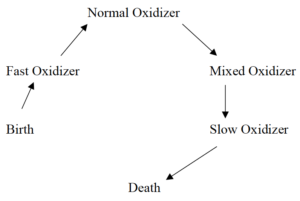
Slow Oxidation –
1. Underactive thyroid gland.
2. Underactive adrenal glands.
___
1. Of course, keep in mind that there are varying degrees of fast oxidation, from slightly fast to extremely fast. Obviously, the person with only a slightly fast metabolism has fewer problems than a person who is extremely fast.
2. As with fast oxidation, there are varying degrees of slow oxidation, from slightly slow to extremely slow. The person who is only slightly slow will suffer fewer problems than a person who is extremely slow.
Part 2: What is meant by your oxidation type
Throughout this report we will refer to various individuals as “fast oxidizers,” or “slow oxidizers,” etc. This is just a way of classifying the rate at which the body is releasing energy from the foods a person eats. Some people refer to this as a person’s “metabolism.”
We have four main classifications: slow oxidizer, fast oxidizer, mixed oxidizer and balanced oxidizer. The word oxidizer comes from the term oxidation. Oxidation, in turn, comes from the word oxygen.
Oxidation is the process by which certain elements in the body chemically combine with oxygen to release energy. Oxidation is the basic chemical process of burning. For example, when you burn a piece of wood, you are oxidizing the wood. You are causing the wood to combine rapidly with oxygen to cause a high-intensity energy release.
Oxidation can occur at different speeds. It is not necessarily a fast process. It can occur quickly, as with burning wood, or it can occur slowly, as in the case of a rusting nail. When a nail is rusting, it is reacting with the oxygen in the air and being consumed. The rust you see is merely the evidence of incomplete combustion.
All oxidation releases energy, whether you feel it or not. The reason you do not feel the heat from a rusty nail is because the oxidation process is occurring too slowly. Heat is being released, but it is dissipating as quickly as it is being released.
The human oxidation rate is the rate at which your cells are “burning” their fuel. When we say that there are various types of oxidizers, we don’t really mean that there are different kinds of oxidation. All we mean is that people release energy from their foods at different rates.
A fast oxidizer releases energy too quickly. He is like a wood stove with a fire that is burning too fast, overheating the room (the body), and running out of fuel. His oxidation rate must be decreased.
A slow oxidizer releases energy too slowly. He is like a wood stove whose fire is too small to heat the room. To help him, you must speed up his metabolic furnace, i.e., increase his oxidation rate.
A mixed oxidizer has an erratic metabolism. Sometimes it is too fast. Other times it is too slow. To give a mixed oxidizer more energy, you must stabilize his oxidation rate.
The balanced oxidizer has the most efficient metabolism. It is neither too slow nor too fast. His system produces the maximum amount of useable human energy. To bring a person into a state of balanced oxidation is the real goal of balancing programs.
Some rates of energy-release are more efficient than others. That is why some people are energetic and others are tired. It all has to do with oxidation rates. This is what the science of human energy is all about, the production of human energy. The more efficient a person’s oxidation rate becomes, the more energetic the person.
The fast oxidizer chart.
The fast oxidizer does not give in to fatigue. He attacks it. He goes into an over-burn so that he can maintain the same pace. The fast oxidizer needs stress to keep him going. If he did not stay hyped-up and keyed up, he would collapse. That’s why the fast oxidizer goes to pieces when things become too peaceful. When things are too quiet, his organs don’t get the stimulation they need to carry on.
___
(Editor’s Note: There are ten or more different classes of metabolisms. For purposes of simplicity, we have discussed only four main types.)
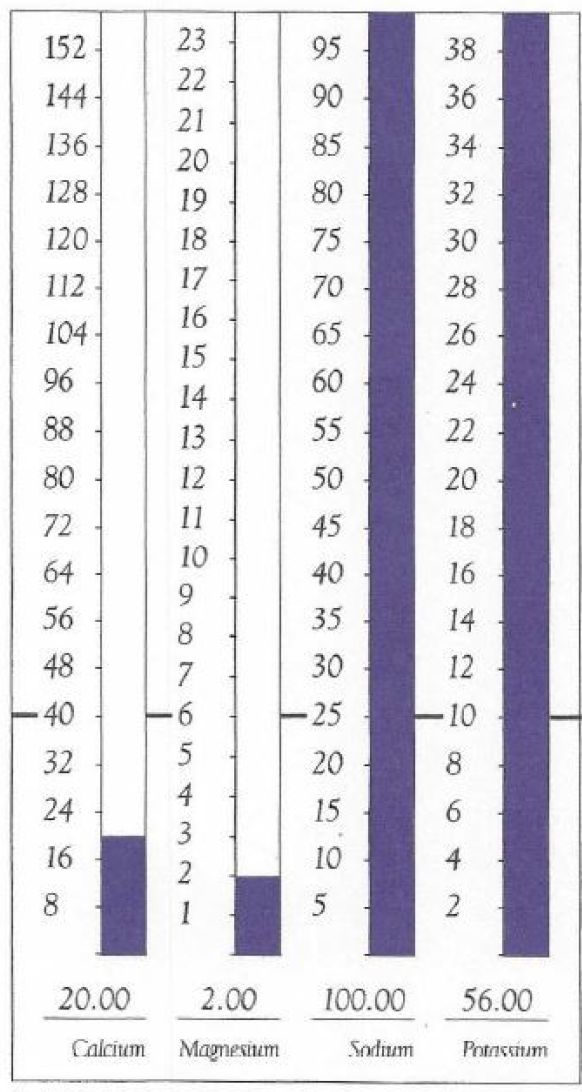
In a fast oxidizer, the calcium and magnesium are low and the sodium and potassium are high. A fast oxidizer has overactive thyroid and adrenal glands.
(Editor’s Note: To make things simple, we have omitted the other minerals in this chart.)
The slow oxidizer chart.
The super-slow oxidizer feels weak and tired. He is lethargic, doesn’t like to start new things, is too tired to even care about things happening around him.
Slow oxidation is basically a defensive holding pattern. The body is in a state of defense against stress – it has gone into a protective shell to ward off any demands on its mineral reserves.
A number of health conditions which are often associated with slow oxidation are:
1. Excessive fatigue
2. Depression
3. Dry skin
4. Poor skin tone
5. Acne
6. Digestion problems
7. Migraine headaches
8. Constipation
9. Overweight
10. Allergies
11. Anxieties
12. Hypoglycemia
There are a number of different types of mineral imbalances associated with slow oxidation. This explains why slow oxidizers may experience other conditions. It is important to stress that all of the above conditions can occur in fast oxidizers, only they are caused by different biochemical reasons.
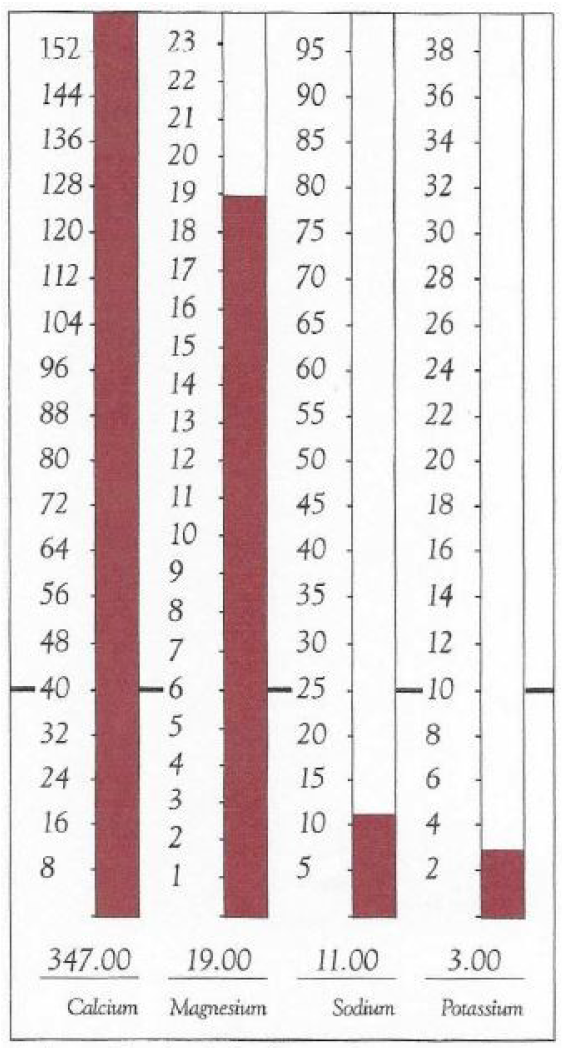
A slow oxidizer has high calcium and magnesium levels and low sodium and potassium levels. A slow oxidizer has an underactive thyroid and adrenal glands.
(Editor’s Note: to make things simple, we have omitted the other minerals in this chart.)
The mixed oxidizer chart.
In a mixed oxidizer, one of the two energy-producing glands (thyroid and adrenals) is fast while the other is slow. These two glands are out of sync. Mixed oxidizers are on an energy roller-coaster, having periods of energy spurts followed by precipitous collapses.
A mixed oxidizer will have a tendency toward either fast or slow oxidation. The further this trend is toward fast, the more pronounced will be the roller-coaster effect. A mixed oxidizer who leans toward slow oxidation will probably not notice much fluctuation at all.
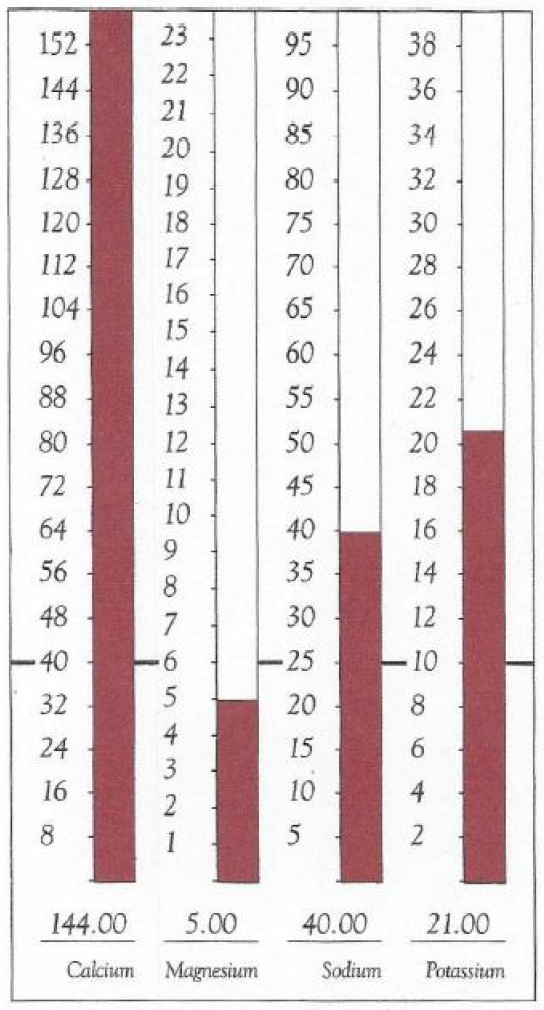
A mixed oxidizer is a person who has one of his two energy producing glands (thyroid and adrenals) slow while the other is fast.
The balanced oxidizer chart.
The balanced oxidizer, the most powerful of all oxidation types, has an oxidation rate that is just right – not too fast and not too slow. Balanced oxidizers are potentially the most productive people of all. Their bodies provide them with a steady, controlled, constant release of useable energy.
They are happy, content, open and uncomplicated. They possess an inner calm and steadiness.
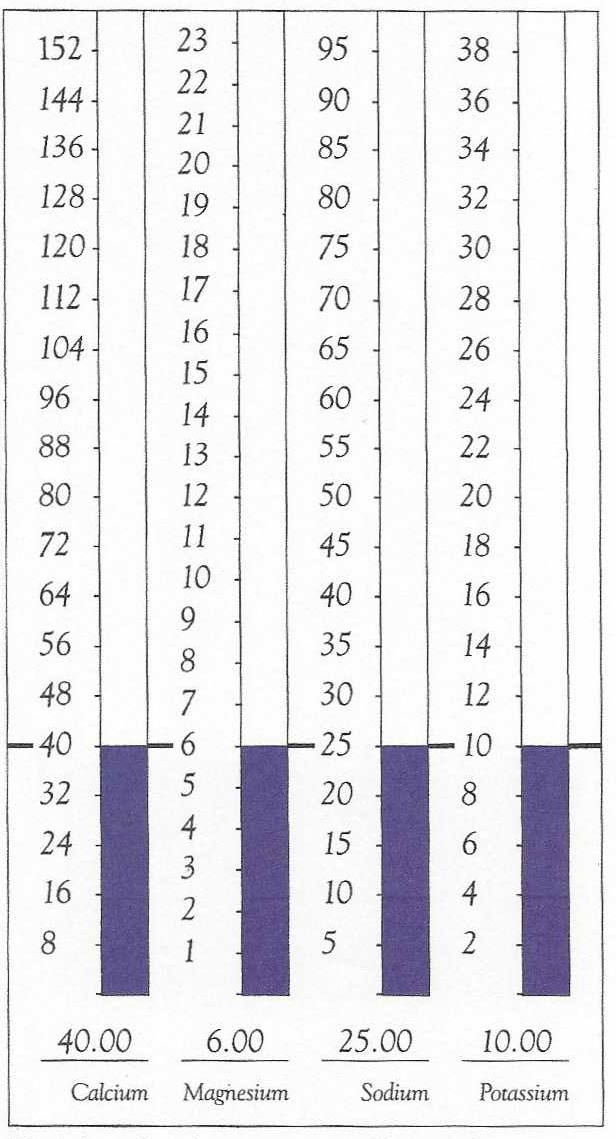
The balanced oxidizer is so unusual it is rarely ever seen. The balanced oxidizer has the levels of his major minerals almost perfect, along with perfect levels for the other minerals in the chart.
A lesson in minerals. “Before” and “After” Hair Charts.
This first chart on the right is of a slow oxidizer. If you will look at the extremely high calcium level (437) you will see that this individual had actually withdrawn into a “calcium shell,” both physically and emotionally, and had become a rigidified person.
The first priority was to bring down the calcium to reduce the rigidity, increase the person’s ability to express feelings, and increase energy levels.
On the second chart, there are a number of major improvements that have occurred in the mineral levels and ratios. Here, you can see the real progress which has been made. For instance, the calcium level dropped from 437 to 157 (normal is 40). The magnesium went from 48 to 29 (normal is 6).
The calcium to potassium (thyroid) ratio went from 13.21 to 1.94. This is actually a swing from an incredibly slow thyroid to a slightly fast thyroid (normal is 4).
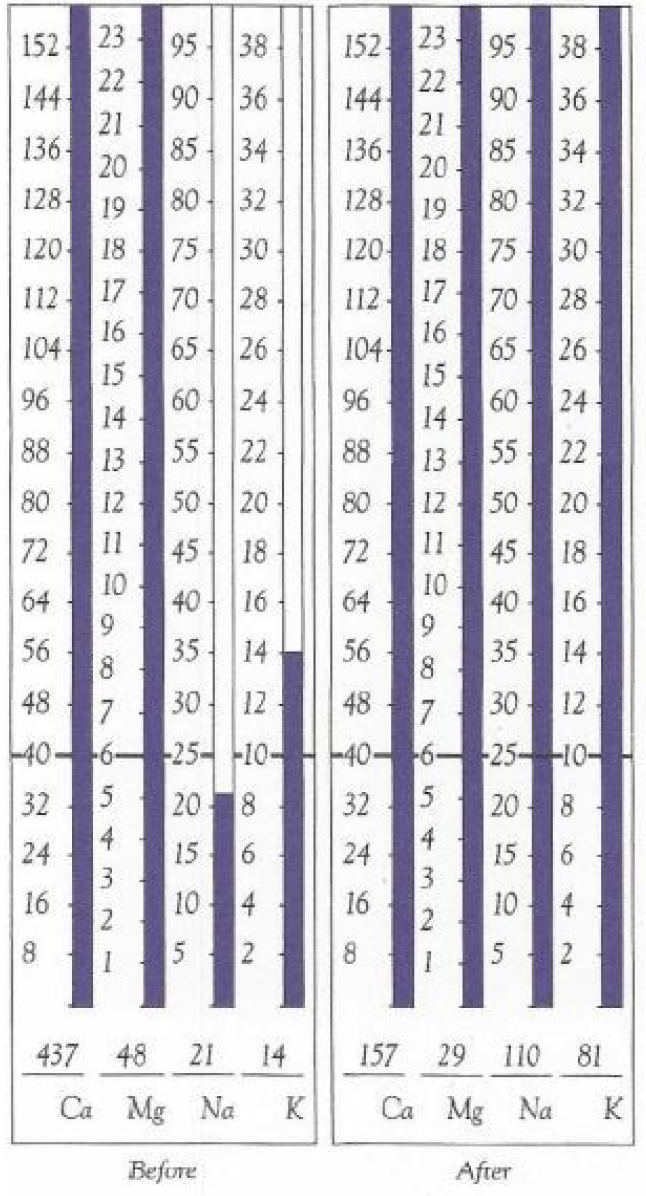
from Energy: How it affects your emotions, your level of achievement, and your entire personal well-being. An interview with Dr. Paul Eck by Colin and Loren Chatsworth. Reprinted by permission.
Take your first step toward a Personalized Active Care Plan! Book a free consultation with me at susan@susancachay.com.
